Report

This article is Section 2.2 of Bain’s 2020 Global Private Equity Report.
In September 2019, institutional investors with $2.4 trillion in assets drew a line in the sand: They made clear that they were serious about wielding their financial clout to combat climate change. With the backing of the United Nations, funds including CDPQ, CalPERS, PensionDanmark, Swiss Re and Allianz joined the Net-Zero Asset Owner Alliance, pledging to transition their investment portfolios to become carbon neutral by 2050. As Allianz CEO Oliver Bäte put it, “Mitigating climate change is the challenge of our lifetime. Politics, business and societies across the globe need to act as one to rapidly reduce climate emissions.”
Skeptics will roll their eyes and say they’ve seen this movie before (cue the 1990s sustainable investing craze that produced little in the way of returns or environmental impact). But a growing number of private equity firms know that conditions have changed dramatically over the past 20 years. If they haven’t built environmental, social and governance standards into their investment strategies already, GPs are fielding uncomfortable calls from their limited partners and employees asking why not.
They are also starting to realize that ESG investing isn’t just about doing good for good’s sake. As social and environmental issues increasingly affect consumer behavior and business conditions, there’s growing evidence that ESG programs can actually improve returns and limit risk.
What’s changed in recent years is that vague discomfort about environmental and social issues has morphed into genuine alarm among investors and consumers. More and more people in both camps view existential global challenges such as climate change, plastics pollution, loss of biodiversity, deforestation, social inequality and water shortages as tangible threats. Conventional wisdom has it that these are “millennial issues,” but the evidence suggests the concern is much broader. According to the Schroders 2019 Global Investor Study, which surveyed 25,000 investors worldwide, more than 60% of those under the age of 71 believe that all investment funds—not just those explicitly defined as sustainable investment funds—should consider sustainability factors when making investments.
Funds are hearing the message. Since 2012, the number of signatories to the UN-supported Principles for Responsible Investment has grown from 1,050 to almost 2,400 funds, a group that controls a staggering $86 trillion in capital (see Figure 2.7). Those funds, a mix of institutional investors and fund managers, have committed to six principles, including a pledge to incorporate ESG issues into how they choose and manage investments.
More and more private equity investors are committing to ESG principles

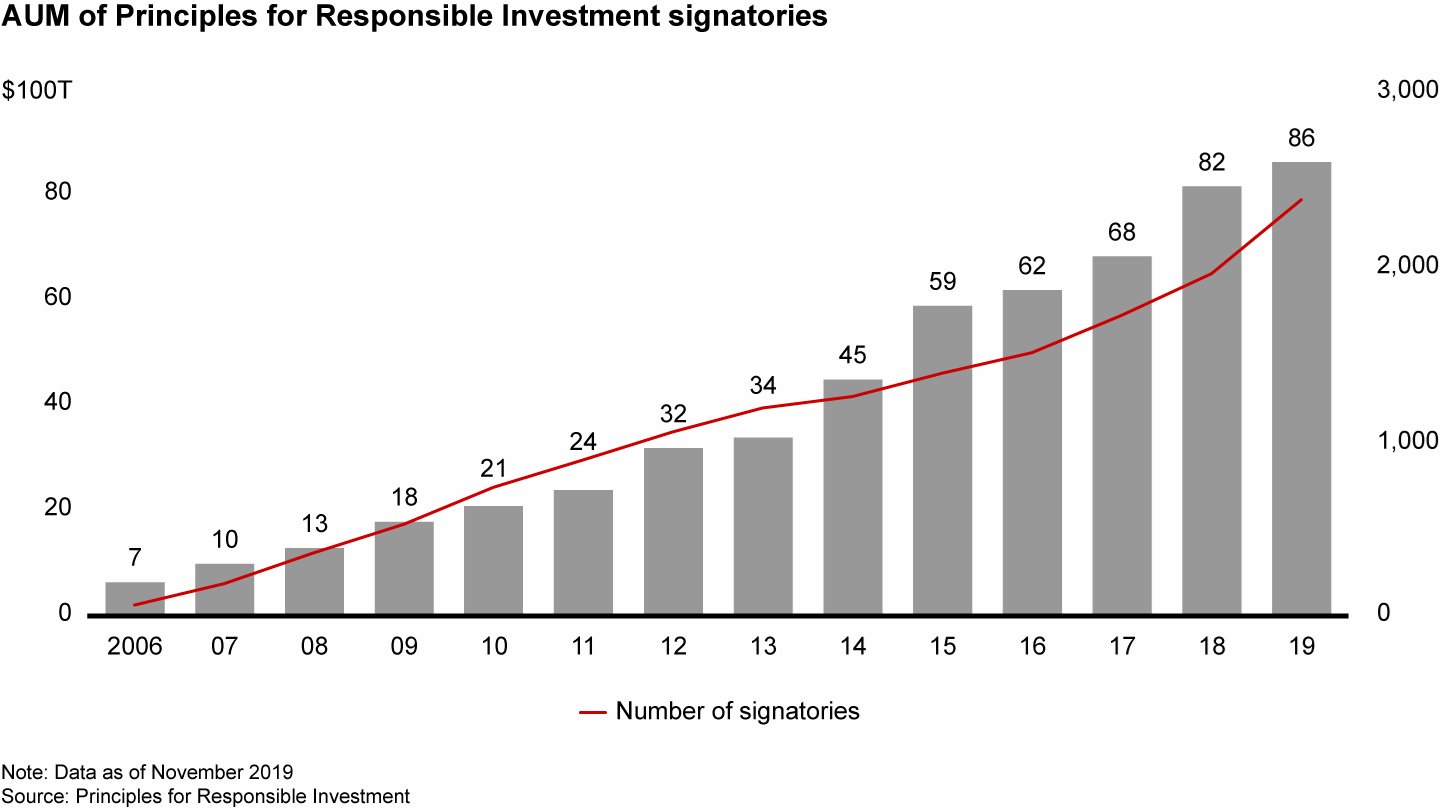
To date, institutions have put less pressure on private equity funds than on public funds to adopt ESG programs. A survey by RBC Global Asset Management found that LPs are less inclined to build ESG criteria into their portfolio choices for private equity than they are for their public, fixed income, real estate or infrastructure asset classes. But as leading institutions become more and more vocal about investing responsibly, forward-thinking GPs are assuming that the pressure from their investors will only build.
Defining the commitment
Though ESG is a broad concept with no standard definition, most can agree on the range of issues it encompasses (see Figure 2.8). How PE firms are addressing the challenge is also highly variable, but they are aligning themselves along a spectrum of ESG commitment (see Figure 2.9).
ESG investing demands sensitivity to a wide range of issues

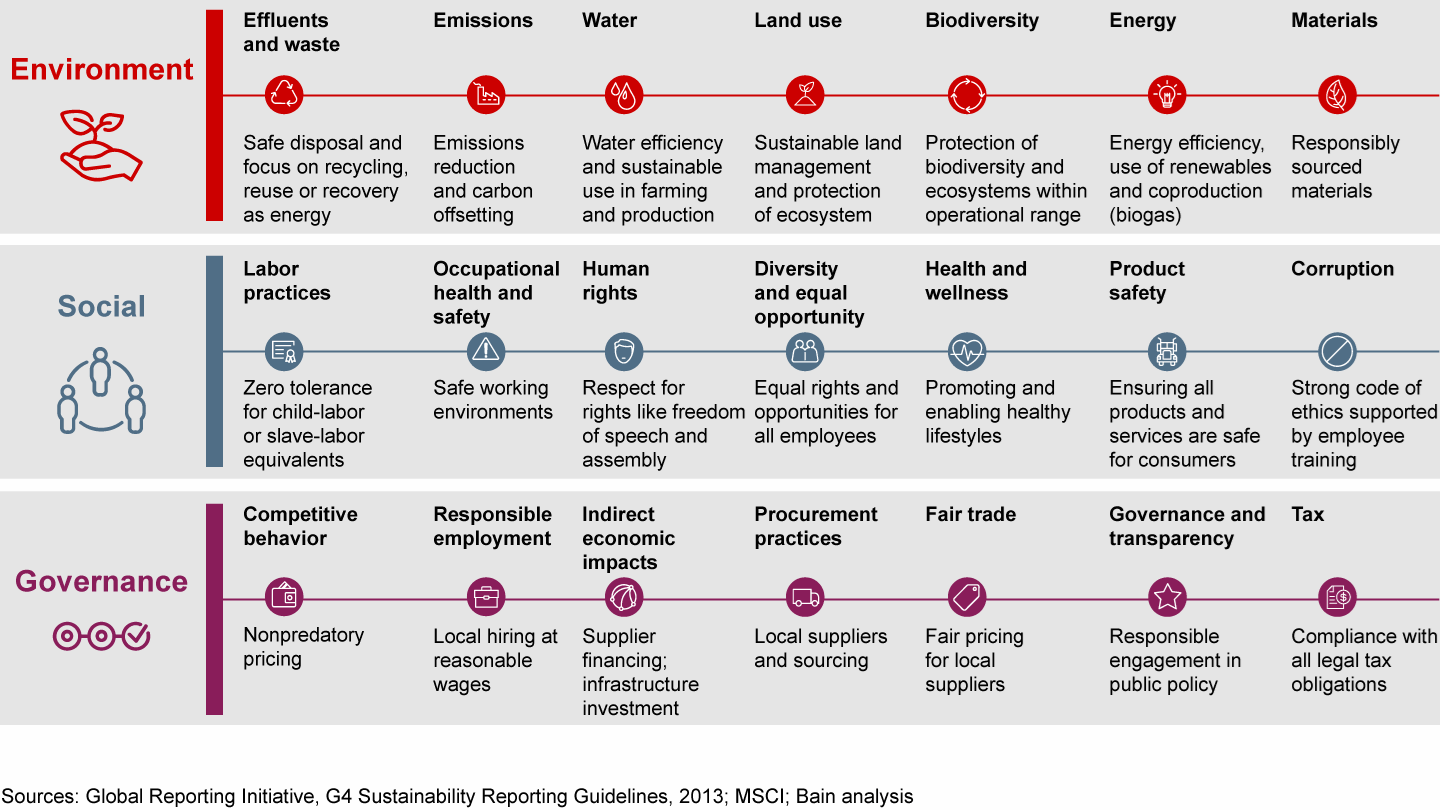
Private equity funds have aligned across a spectrum of ESG commitment

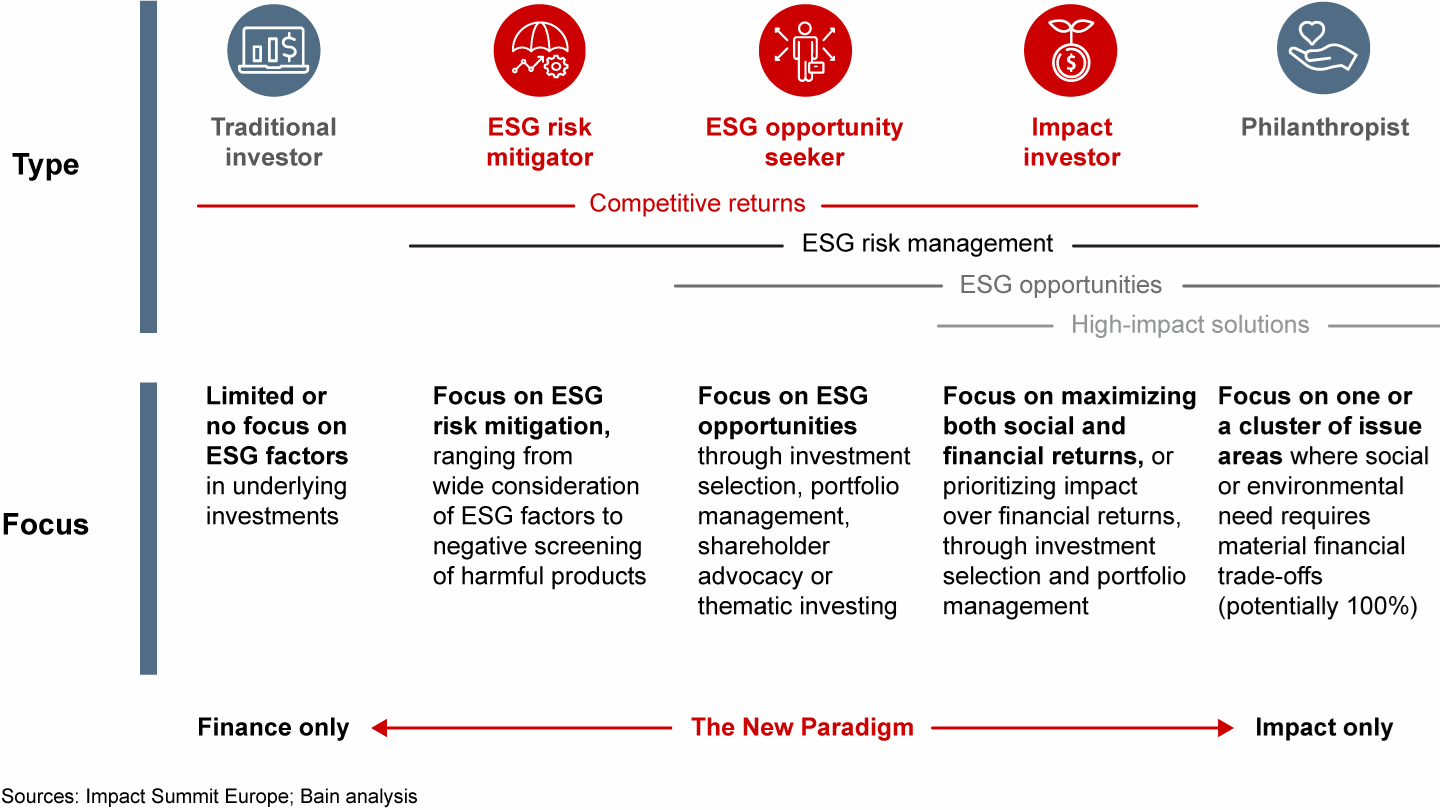
At one end are traditional investors that have yet to get on board. Next come those taking the “cover your backside” approach by ensuring that their portfolio companies are at least compliant with existing regulations and doing nothing wrong in the social/environmental arena.
Further along the spectrum are the firms that are embracing ESG principles across the investment value chain, from identifying targets and due diligence to value creation during ownership. They view it as an opportunity to seek out companies where doing the right things adds value by attracting more customers, cutting costs or avoiding reputational harm.
Finally there are the impact investors. These firms represent a small part of the market, but they are raising increasingly large funds with the explicit goal of investing in companies that can produce both ESG-style impact and market-rate financial returns.
The question of returns, of course, lies at the heart of whether ESG and impact investing will continue to gain traction in private equity. If doing good means compromising performance (as many assume), the momentum behind these efforts will likely fizzle out eventually.
Yet evidence is building that ESG investing may enhance performance, not detract from it. Over the past 16 years, a STOXX index of global ESG leaders has outperformed the STOXX Global 1800 Index by 37%. And in 2015, DWS teamed with the University of Hamburg to do a meta-study of more than 2,000 independent research efforts. They found that 63% of the studies discovered a positive correlation between ESG investing and returns, while only 8% showed a negative effect (see Figure 2.10).
Evidence is building that ESG investing can strengthen financial returns

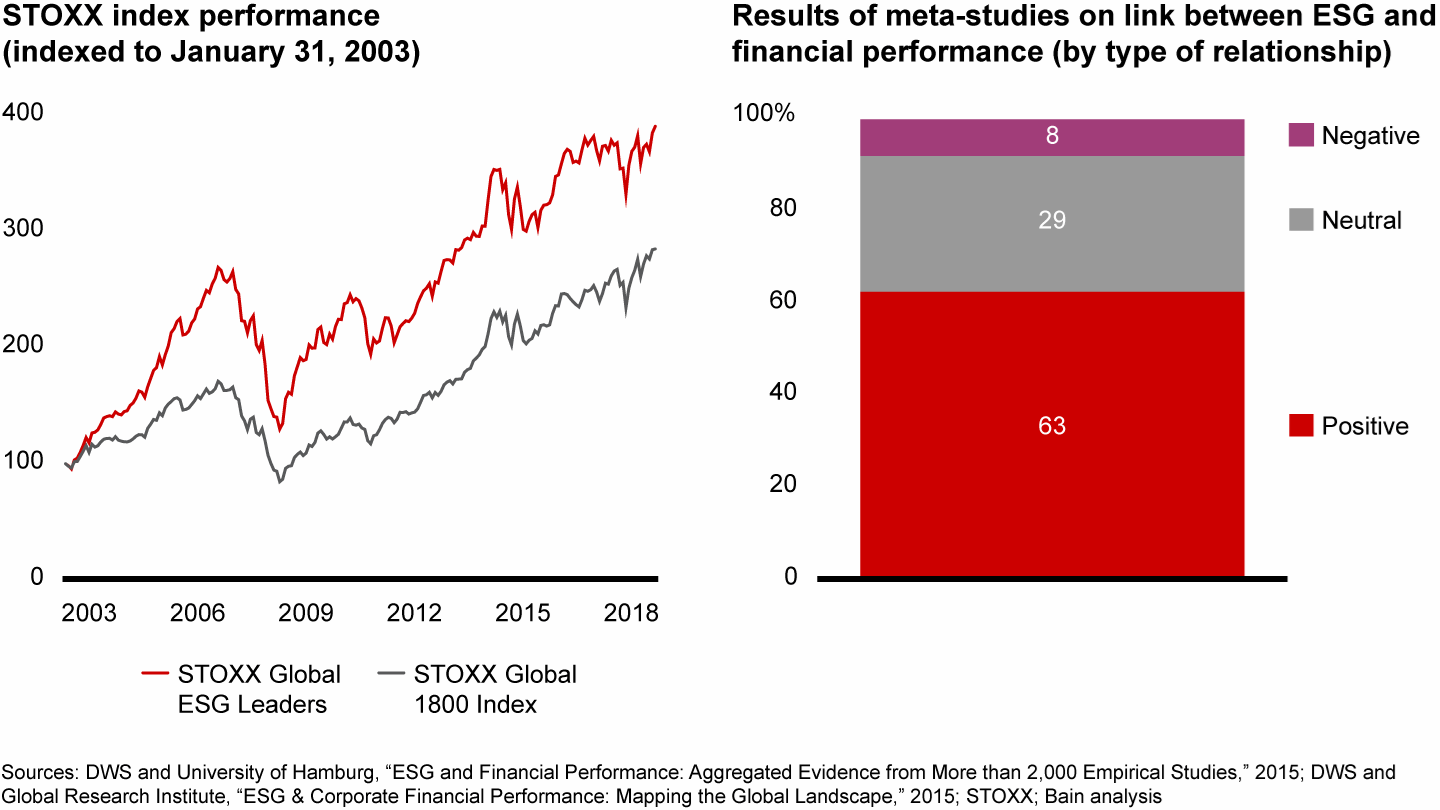
These studies involved public equities, not private funds or assets. But the RBC study of PE investors showed that LPs are increasingly convinced that ESG investing can pay off by boosting returns, increasing alpha and mitigating risk (see Figure 2.11).
Private equity investors are warming up to the idea that ESG investing doesn’t compromise performance

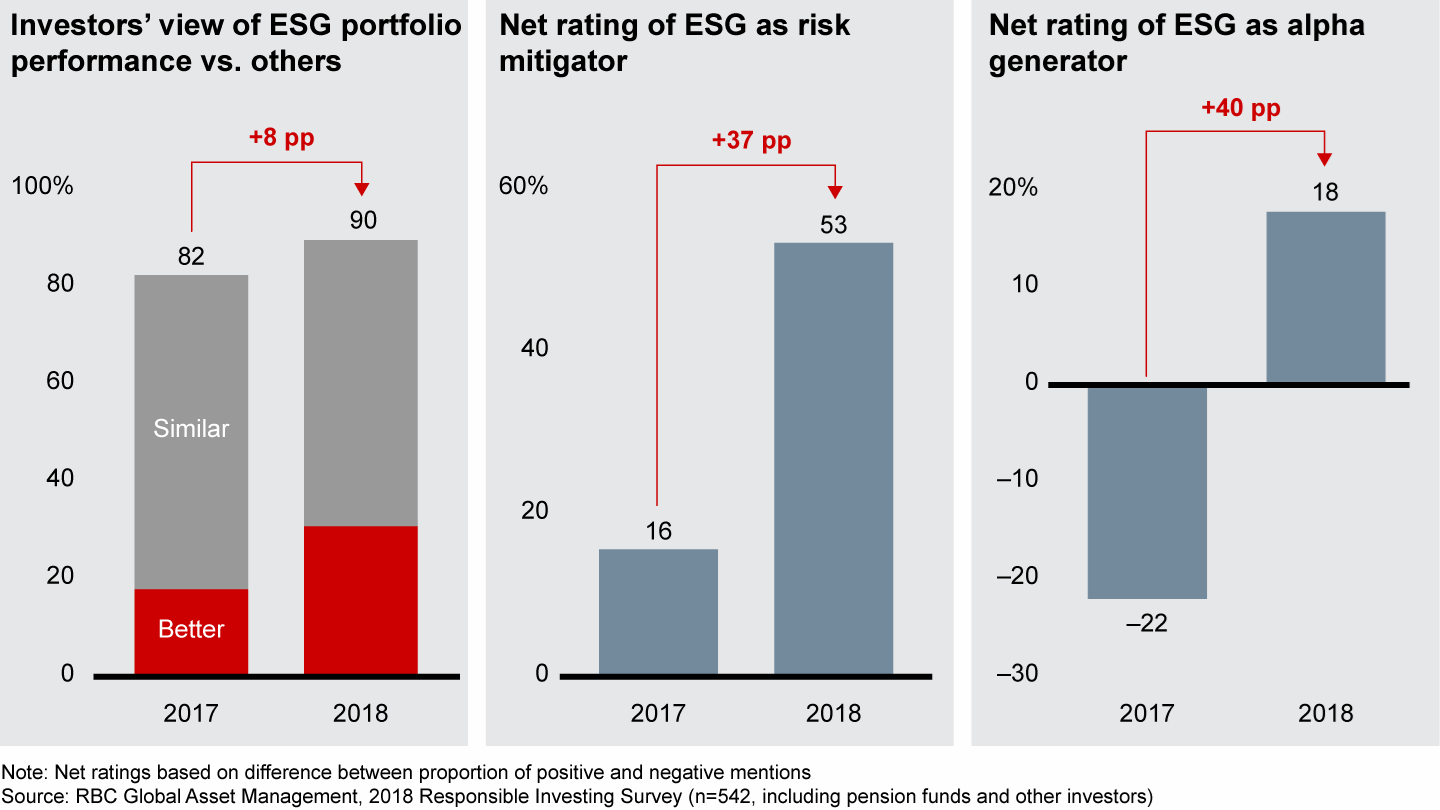
It’s clear that consumers really do care about ESG issues. Concern about what’s happening in the world is driving purchase decisions. A 2018 Nielsen study of chocolate, coffee and bath products in the US found that sales of products making environmental claims were growing at least four times faster than rival products.
Young people, especially, are voting with their feet. A study by Morgan Stanley’s Institute for Sustainable Investing indicated that millennials are twice as likely as the overall population to buy products from sustainable businesses. That’s a significant consideration for any company selling goods. Given that $30 trillion in wealth will shift from baby boomers to millennials over the next 30 years, the ESG effect on consumer preferences may be just getting started.
It’s also evident that operating sustainably can have cost benefits. As companies focus on reducing their environmental footprint, they are making changes to their supply chains and operations that end up consuming fewer resources. Unilever, for instance, has saved $1 billion since 2008 by proactively cutting its water, energy and materials usage. Water- and energy-saving measures implemented at 11 KKR portfolio companies were expected to generate $11 million in annual savings starting in 2019.
Investors likewise are finding they can generate upside by turning a bad actor into a good one. That was the calculus in 2009 and 2010 when Carlyle built a 29% stake in Yashili, one of China’s largest infant formula companies. The company had suffered major reputational damage when it got caught up in China’s nationwide melamine scandal, and turning it around involved several ESG initiatives. Carlyle helped Yashili replace local raw material with 100% imported high-quality milk powder. It established a food quality and safety advisory committee, the first of its kind in the industry. It recruited a new chief quality advisor and introduced stringent new standards.
By 2013, the firm’s reputation had been repaired and Carlyle was able to sell its equity for around $388 million, a healthy 2.3x return on its initial investment.
Forming an ESG strategy
Wherever a firm establishes itself on the ESG continuum, developing a strategy to guide both investment and value creation is critical. That starts with outlining a clear ambition for how the firm intends to balance financial returns and ESG impact, how it will define its investment approach, how it will measure results and how it will communicate with stakeholders. The best ESG strategies then spell out specific operating changes within the firm and a clear timeline for implementation. The goal is to embed ESG considerations throughout the investment value chain, from deal sourcing and due diligence to monitoring and realizing ESG goals during ownership.
To identify and manage ESG risks and opportunities, GPs will need to develop new expertise or partnerships. That includes getting early warnings on ESG ratings for target companies, being able to factor in and deliver on key ESG initiatives, and helping portfolio companies take action—for instance, by driving a carbon-efficiency program or supporting them in developing sustainable procurement practices. EcoVadis, which received a $200 million investment from CVC in January 2020, enables exactly this. As a market leader in global ESG ratings, EcoVadis provides an innovative online platform that allows firms to efficiently identify and manage environmental, social and ethical risks, based on an array of proprietary and public data sources.
KKR started its ESG journey about a decade ago, launching its Green Portfolio Program in partnership with the Environmental Defense Fund and then signing on to the UN’s Principles for Responsible Investment. The effort picked up steam in 2018, when the firm introduced its Global Impact strategy with the explicit goal of generating private equity risk-adjusted returns while investing in companies that help provide solutions to the UN’s Sustainable Development Goals. The firm laid out a number of criteria for how it would weave ESG considerations into the investment process, from deal sourcing to exit. That started with a policy to consider ESG issues like water usage, emissions, product safety and labor practices when screening investments.
KKR also created a dedicated ESG diligence group made up of experts from legal, compliance, global macroeconomics, public affairs and the KKR Global Institute. This group, which reviewed 230 potential investments in 2018, is charged with examining deals to identify specific ESG risks and opportunities—considerations that are then built into the deal’s plan for the first 100 days. These efforts are guided by 37 industry-specific lists the firm created to flag ESG-related issues that could be financially meaningful to companies.
During ownership, KKR is committed to improving both financial performance and ESG impact. It also has a formal monitoring process to ensure portfolio companies are living up to ESG-related commitments.
All of this came into play when KKR bought Unilever’s spreads business (now called Upfield) for $8 billion in 2018. While margarine and other plant-based spreads were in decline, the Unilever business was highly profitable and had strong brands like Country Crock in the US and Flora in Europe. KKR’s ESG diligence team, however, raised a major red flag: The company was heavily reliant on palm oil, the rapid expansion of which poses many environmental issues.
Although this clearly upped the risk calculus, KKR decided in the investment committee process that solving the problem could present an opportunity. The firm’s experience working to build sustainable supply chains for other companies was a point of differentiation in the bidding process and could add value to Upfield. The company and its new owners set a goal of sourcing 100% of its palm oil from sustainable sources and achieved it by October 2019. Plant-based products from responsible sources are healthier than dairy, with a smaller CO2 footprint. That not only makes the company more valuable by creating goodwill with consumers, but it also removes a significant source of risk from the equation.
Committing to strong returns and impact
While the best ESG programs generate a real commitment to environmental, social and governance standards, impact funds take responsible investing to the next level. Adopting an ESG program doesn’t necessarily lock a firm into generating measurable impact with its portfolio companies. But an impact fund is raised on that explicit promise: It will generate competitive returns and measurable impact. What was initially the territory of pure impact players like LeapFrog or Bamboo Capital has now attracted mainstream funds. Since 2015, impact fund assets raised or currently being raised have grown 154%, to $28 billion (see Figure 2.12).
The amount of capital raised by dedicated impact funds is accelerating

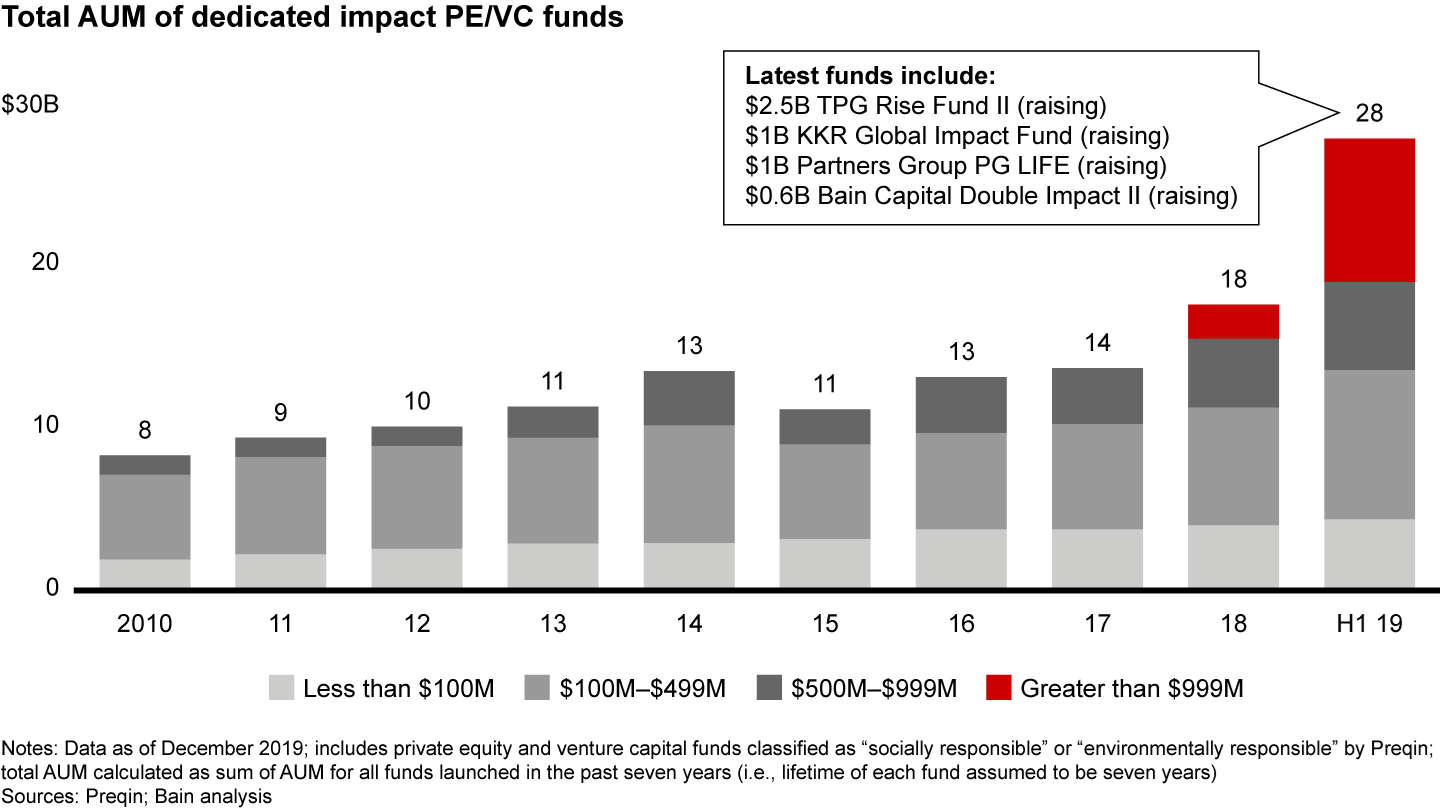
Notably, the number of megafunds—those with assets under management of $1 billion or more—has climbed sharply over the past two years. TPG leads the pack with its $2 billion Rise portfolio and is on the road raising a new $2.5 billion fund. It also has the highest profile; its star-studded board includes U2’s Bono and Laurene Powell Jobs as members. Other firms like KKR and Partners Group are raising $1 billion impact funds, while funds like Bain Capital Double Impact are out raising slightly smaller portfolios.
Some of this activity is doubtless opportunistic—firms are taking full advantage of this “ESG moment” to raise more capital and to create a halo effect around their organizations. But they are also publicly committing themselves to proving that impact investing can work, that they can both make money and make a difference.
Measuring impact isn’t easy, and the industry is in the early days of devising standardized metrics investors can use to gauge results. There are some helpful guideposts like the UN’s Sustainable Development Goals, which provide a framework of 17 sustainability objectives. Companies are also turning to a standardized measurement methodology, the Global Impact Investing Rating System (GIIRS). Developed by the nonprofit B Lab, GIIRS uses a tool called B Impact Assessment to provide an accounting of the portfolio’s impact on workers, customers, communities and the environment. Many firms have also developed their own tracking mechanisms.
That was the case at TPG, which makes measurement of potential impact a central part of due diligence for its Rise Fund investments. Before committing any money, the fund screens deals to ensure they have potential to produce both high impact and a good return. TPG partnered with the nonprofit Bridgespan Group to develop an evidence-based methodology for quantifying the potential impact of target companies. It estimates the financial value of the social and environmental good that is likely to result from each dollar invested in a given target and assigns it a value called impact multiple of money (IMM), explained at length in the January–February 2019 issue of Harvard Business Review. Rise will invest in a company only if the IMM calculation signals a strong social return on investment. Using the IMM helps TPG direct capital where research supports social impact, allowing the firm to compare investments across sectors and regions. It also helps build trust and confidence among the firm’s stakeholders.
In 2017, the IMM approach led TPG Rise to EVERFI, a cloud-based educational platform that delivers digital learning content. Schools and corporations use the software to combat social issues like alcohol abuse, sexual assault, and low financial and digital literacy. EVERFI was attractive for several reasons. First, the company scored a high IMM, as it could tie its courses to measurable outcomes addressing a broad range of problem areas. It was also a great enterprise SaaS business. The company had doubled in size over the previous three years, with approximately 95% recurring revenue, 100% net retention rates and strong sales efficiency.
TPG Rise and TPG Growth Fund combined to lead a $190 million investment round. Rise then worked closely with the company’s management to increase go-to-market effectiveness, build more efficient customer networks, and develop finance and M&A strategies. It also introduced EVERFI to new potential clients within the TPG portfolio.
The investment has allowed EVERFI to continue building out its platform with additional content, data analytics and impact reporting capabilities. Since TPG Rise entered the picture, over 6 million students have completed EVERFI courses, bringing the total since inception to more than 22 million. That has led to a realized IMM of approximately 5x. The company has also continued to perform well financially. Since 2017, revenue has grown at around 20% annually, with over 100% net retention.
Data on whether impact funds overall are delivering competitive financial returns is inconclusive. A 2019 survey by the Global Impact Investing Network (GIIN) indicated that impact funds seeking market-rate performance produced realized returns of greater than 16% since inception—higher than what most LPs would expect from an emerging market PE fund investment.
But GIIN also worked with Cambridge Associates (CA) on a study that produced a less positive outcome. It targeted about 80 impact funds, excluding philanthropic organizations. Pooled returns lagged CA’s emerging market private equity and venture capital index by 2 to 6 percentage points across any given timeline. Smaller impact funds (less than $100 million) did better: Over a one-year period, they delivered a 15.7% pooled IRR, compared with 8.5% for CA’s emerging market private equity and venture capital index.
Studies conflict partly because there hasn’t been sufficient time to build reliable return data for the impact fund class. Individual funds, however, continue to raise money, presumably on the strength of past results. TPG’s Rise Fund II is targeting $2.5 billion, with $1.7 billion in commitments already secured as of late 2019. LeapFrog closed its third fund at $700 million in the second quarter of 2019 and was oversubscribed by $100 million. It reports that revenues for its portfolio companies have grown 35% annually, on average, since investment, helping LeapFrog to achieve nine successful exits, which have delivered returns of between 2x and 3.5x. In terms of impact, those companies have provided essential products and services to more than 188 million people, most of them in emerging markets and living on less than $10 a day.
LeapFrog, an impact investing pioneer, has also developed a proprietary measurement framework that benchmarks financial, impact, innovation and risk management factors against global best practices. It targets companies that are scalable and consumer focused, with the governance to grow and endure. They are clustered within the healthcare and financial services sectors, where the LeapFrog team has differentiated expertise, and the firm looks for opportunities to utilize innovative technology or business models to enhance access for low-income consumers in Asia and Africa.
A good example is BIMA, a pioneering insurance business launched in 2010. Within 18 months of its founding, the company was delivering life and health products via mobile phones to nearly 4 million people in Ghana, Tanzania, Senegal, Mauritius, Bangladesh and Sri Lanka. LeapFrog started investing in 2013 on the premise that, while consumers in emerging markets may not have access to basic financial services, they almost always have access to mobile infrastructure. By partnering with mobile network operators, BIMA had found a low-cost distribution channel that allowed it to provide insurance products for as little as 20 cents to $6 a month. “This radical affordability puts the safety net of insurance within reach of millions of low-income customers in emerging markets for the first time,” said LeapFrog partner Stewart Langdon.
BIMA supplied the underwriting capability, and LeapFrog’s team supplied expertise in product development, branding and consumer insights. It also fostered strategic relationships, including a partnership with another LeapFrog portfolio company in Ghana called Express Life Insurance, which sold products through BIMA’s mobile network. Under LeapFrog’s ownership, BIMA expanded from 6 to 11 markets globally, and by mid-2018, the number of people it served had grown to 10 million, three-quarters of whom previously had no access to insurance. The fund sold its equity to Allianz in 2017 for $97 million, logging a significant return.
Bain Capital Double Impact launched in 2017 with $390 million in capital and is currently on the road to raise $600 million more for a second portfolio. It uses the B Impact Assessment metric to gauge ESG impact. Its portfolio companies have increased their BIA scores by an average of 42% under Double Impact ownership.
Three elements gave Bain Capital confidence that impact investing could work. First, it believed that businesses with a vision beyond just making money grow faster. Second, it had seen plenty of strong proof points, including Unilever’s 2016 acquisition of Seventh Generation cleaning products, which delivered a coalition of PE owners a reported 6x to 7x return. Finally, Bain Capital knew it could rely on its array of capabilities to add value during both diligence and ownership.
A good example of Double Impact’s approach is the fund’s May 2019 investment in Rodeo Dental & Orthodontics, a Texas-based company with a mission to deliver high-quality dental care to underserved communities. GPs have traditionally shied away from dental companies with Medicaid exposure, given their less favorable economics and the potential for fraud and abuse. But Rodeo was already generating high growth at attractive margins, and Double Impact saw the opportunity to sharpen its model and expand its mission.
The firm has supported Rodeo’s expansion into new markets and enhanced its leadership. It has also helped the company hone its business approach. Rodeo tries to make dental visits fun and uplifting by decorating office waiting rooms with entertaining themes that change frequently. In addition, educational outreach helps build strong community connections that increase demand. Making the Medicaid model work involves scheduling and staffing with the optimal ratio of dentists and assistants. Children who qualify for Medicaid often come to Rodeo with significant deferred dental maintenance. By addressing all of the child’s dental needs at once, Rodeo performs multiple services per appointment, which boosts productivity per visit.
So far, so good. The investment is still in its early days, but Rodeo is tracking above target and is increasing its reach in existing and new markets.
There is no plug-and-play ESG strategy. Every firm has to develop its own approach based on a unique blend of strategy, culture and stakeholder preferences. The savviest firms are already figuring out how to play ESG to their advantage, and a growing number are going all the way by launching impact funds. What’s evident is that no private equity firm can afford not to think about ESG. The pressure will only increase to mobilize large pools of investment capital to combat the world’s most intractable problems.
Explore the report
More from our 2020 Private Equity Report
Private Equity Report
This article is part of our 2020 Global Private Equity Report.